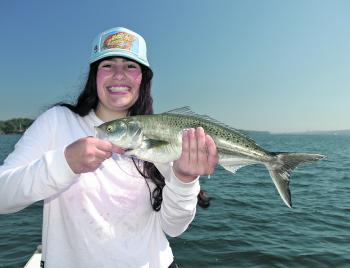February is a great month to nail some big kings in the harbour. They are back from their spawning run and hungry for big squid. The classic spots like Old Mans Hat, the Watsons Hole, the Cakes and Shark Island should hold the big ones. Squid baits are a must and you should find plenty around the deeper kelp beds on the lower harbour.
While the salmon won’t be around in numbers much after February, this is probably the easiest time of year to catch them on lures. The bait has grown to a size that is easy to match with a lure, and the warm water has them feeding in overdrive. You will find them well inside the Harbour, North Harbour and occasionally even up Middle Harbour.
This season has produced some great bream fishing for bait and lure fishers alike. Bream are found right throughout the system from the freshwater reaches right down to the ocean washes around the heads.
Bream source the bulk of their feed on the intertidal zone. This means that, in general, the most productive sessions will be had on high tide and in shallow water. Just think about where and when you collect your prime bream baits. Yabbies, worms and pipis are all collected on the sand or mud flats at low tide. Black crabs and oysters are also collected at low tide around the rocky foreshores. We access these creatures at low tide but the bream can only access them at high tide, and that is where you will find the fish, especially early in the morning, late in the afternoon and at night.
Don’t be scared to get your boat right up over the sand flats, and if you’re fishing from the shore, cast along the banks (instead of as far as you can towards the middle). Around 80% of bream I have taken, come from water less than 4ft deep.
Bream will eat pretty much everything that’s fresh, and plenty of stuff that isn’t. They are opportunists, but this doesn’t mean that they won’t actively hunt live prey. Examination of a bream’s stomach contents will nearly always reveal shell grit, particularly in the bigger specimens. I was cleaning a good-sized bream the other day at Berowra and found only a yellowish pasty substance in its stomach. I had no idea what it was until I found a small label stuck to one piece with ‘Jarls’ printed on it – it was half of the Jarlsberg cheese label. The only problem was that we hadn’t been using cheese for either bait or berley.
Top bream baits include mullet and chicken gut, skirt steak, chicken breast fillet, prawns and fish flesh pieces. I stress fresh for all of the above. You can also use prawns, yabbies, worms, pipis and black crabs.
Tackle for bream can be as simple as a handline, and I know people who still prefer this method. More common these days is a rod and reel combo matched for 4-6kg line. The Baitrunner style of reel became very popular in the 90s among the majority who prefer to let their bream run before striking. This system allows the angler to let the fish run straight off the spool while the bail remains closed. A quick flick of the lever, the spool is engaged, and you are in direct contact with the fish.
I don’t let the fish run. I find I get more positive hook-ups by either striking immediately or just leaving the rod in the holder and letting the fish hook itself. A light threadline or baitcasting outfit capable of holding 200m of 4kg matched to a light spinning rod about 1.8m would be ideal.
My rig consists of a running sinker above a swivel on the main line with a trace of about 0.5m of 6kg line finished off with a size 4 to 1\0 hook depending on the bait being used. You should only use enough lead to hold bottom. Very often no lead at all will prove the most effective.
Lure fishing for bream is also very popular and it seems to work better in some areas than others. The most productive areas are the shallow muddy spots where the water clarity is very low, such as the upper reaches of the Parramatta and Lane Cove Rivers. Both trolling and casting are equally effective, and once again over the shallows at high tide will produce best results. The best lures are usually small and brightly coloured. Small suspending jigs are the most versatile if you are casting to structure, while small minnow lures are best for trolling.
• If you are interested in doing a guided fishing trip on Sydney harbour with Craig McGill please call 0412 918 127 or email --e-mail address hidden--
Reads: 3322
Big kings are suckers for big live squid.

Salmon will be at their best this month.

The Harbour has been experiencing one of its best bream seasons for many years.




